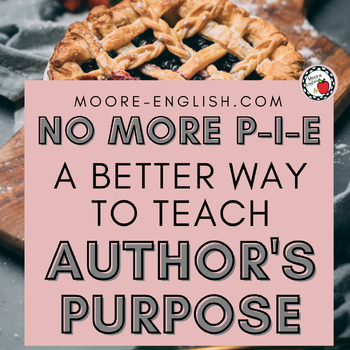Move Beyond P-I-E and Get the Receipt: A Better Way to Teach Author's Purpose
- Google Drive™ folder

What educators are saying
Also included in
- At the secondary level, it can be difficult to think about teaching reading comprehension. Sure, there's a standard for that, but there are so many other standards beyond reading comprehension. As a high school language arts teacher, I may not teach phonics or phonemic awareness, but I do teach readPrice $6.99Original Price $7.47Save $0.48
Description
Let me make a confession: A few years ago, I got very invested in the drama between Taylor Swift, Kanye West, and Kim Kardashian. For me, one of the biggest take aways from that drama was the phrase "Show me the receipts." I'd heard my students talk about "receipts" before, but something about the Kanye-Taylor drama really made that phrase memorable to me.
As a teacher, I turned that phrase over in my mind. Where are the receipts in the English classroom? Well, when students are looking for author's purpose, they are looking for the receipt!
Until this year, I'd used the classic P-I-E to teach author's purpose, but I'd long found that acronym to be limited. P-I-E lacks nuance. It doesn't meet students' needs as they begin to read more complex texts.
That's where getting the receipt comes in! "Receipt" is my new acronym for teaching author's purpose. It offers students the chance to analyze texts at greater depth.
To help you bring "Receipt" to your classroom, I've put together three charts, text questions, sentence stems, and 2 anchor chart options. These come with lots of options so you can determine which tools meet the needs of your students! Everything is available in a .pdf and a Google Slides presentation.
Includes:
- Questions for determining author's purpose
- Sentence steps for determining author's purpose
- "Look Fors" to determine author's purpose
- 2 anchor charts
- 3 book marks
Use these tools to help students attack these texts:
-6 Tools for Teaching "Privileged" by Kyle Korver
-4 Tools for Teaching "The Danger of a Single Story"
-3 Tools for Teaching "The Immigrant Contribution" by JFK
-"Words and Behaviors" by Aldous Huxley Analysis Questions
-Thomas Paine's The Crisis No. 1 Questions, Prompts, SOAPTone, and Google Form
-"Speech at the Virginia Convention" Questions, Prompts, and SOAPSTone Analysis
-"Sinners in the Hands of an Angry God" SOAPSTone Analysis and Reading Questions
Keep in touch and get more great ideas for teaching secondary ELA!
Read more about poetry annotations on Moore English. Check out these posts:
-4 Steps to Pre-Read ANY Nonfiction of Informational Text
-How to Teach Text Features: Strategies for Student Success
-15 Places to Find New, High-Quality Texts for Your Classroom
-10 Interesting Poems for Helping Students Master Inference
-10 Memorable Poems for Helping Students Master Main Idea
Credit for Comments
Thank you for downloading this product. I’d love your feedback, and for each rating and comment you provide, TpT will give you credit toward a future purchase! Login in to your TpT account, click My Purchases, and beside each purchase, you’ll find a link to Provide Feedback! Rate, comment, and earn TpT credit! Let me know how you use this product in your classroom, what resources I should work on next, and ideas you have for Moore English






